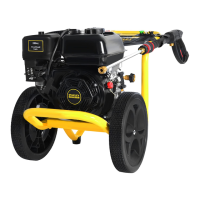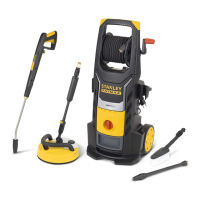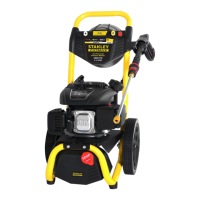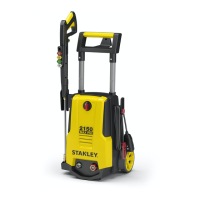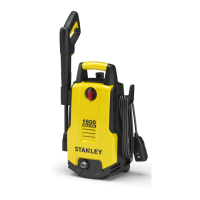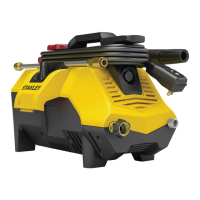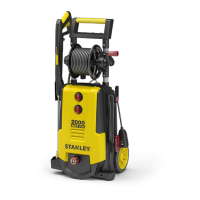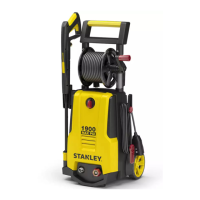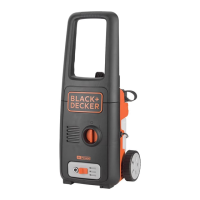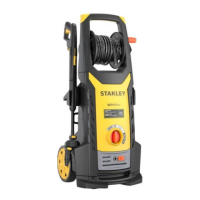15
ENGLISH
(Original instructions)
Preparing Spray Lance (Fig.A)
IMPORTANT: Before turning on the pressure washer unit,
disengage the trigger lock-off button
9
and squeeze the
trigger
10
.
1. Spray lance must be assembled before use. Please refer to
Attaching Spray Gun under Assembly andAdjustments.
2. Disengage the trigger lock-off
9
.
3. Turn on the watersupply.
4. Squeeze the trigger
10
. Hold the trigger for 30seconds to
purge the system ofair.
5. If air is still found in the water stream, continue to run
water through the spraylance.
Cleaning a Surface (Fig.M)
1. To start the pressure washer, toggle the speed switch
selector
12
to the HI or LOposition.
2. The best angle for spraying water against a cleaning
surface is 45°.
‑ Spraying head-on tends to cause dirt particles to
imbed in thesurface.
‑ When working on vertical surfaces, it is best to
apply detergent starting at the bottom and working
upwards which will prevent the detergent from sliding
down and causingstreaks.
3. To disengage the spray gun, release thetrigger.
Moving the Pressure Washer (Fig.A, B)
1. Turn OFF the pressure washer unit
11
and toggle the
speed switch selector
12
to the centre position. Then turn
off the watersupply.
2. Point the spray lance
5
in a safe direction and pull the
trigger
10
to release remaining waterpressure.
3. When the spray lance is completely empty, pull up the
telescoping handle
16
and pull the pressure washer unit
using the wheels
21
to your nextlocation.
Shutdown (Fig.A)
1. Turn OFF the pressure washer unit
11
by toggling the
speed switch selector
12
to the centre position. Then turn
off the watersupply
and
remove the battery packs from
the pressure washer unit
11
.
2. Discharge residual pressure by squeezing the trigger
10
until no more water comes out of the spray lance
5
.
3. Engage the spray trigger lock-off button
9
.
4. Disconnect the garden hose from the water intake
18
.
5. Disconnect the high pressure hose
1
from the high
pressure water outlet
19
and drainhose.
Nozzle Cleaning (Fig.A, N)
WARNING: To reduce the risk of serious personal
injury, turn unit off and remove the battery pack
before making any adjustments or removing/
installing attachments or accessories. An accidental
start‑up can causeinjury.
If the nozzle becomes clogged with foreign materials, such as
dirt, excessive pressure may develop. If the nozzle becomes
partially clogged or restricted, the pump pressure will pulsate.
Clean the nozzle immediately using the nozzlecleaner.
1. Turn OFF the pressure washer unit
11
by toggling the
speed switch selector
12
to the centerposition.
2. Turn off the watersupply
and
remove the battery packs
from the pressure washer unit
11
.
3. Pull trigger
10
on spray gun
7
to relieve any
waterpressure.
4. Remove the nozzle from the spray lance by depressing
thebutton.
5. Using the nozzle cleaning pin
25
unclog any debris from
the nozzle.
6. Run water from a faucet or garden hose through
thenozzle.
Self Priming Suction Hose (Fig.H)
1. To clean the self priming suction hose
2
, shut off the
pressurewasher.
2. Pull the trigger switch to relieve any waterpressure.
3. Remove the suction hose
2
from the pressurewasher.
4. To clean the suction hose, use water from a garden hose
to thoroughly rinse out the suction hose and allow it to
fullydry.
Suction Hose Filter (Fig.O)
1. Turn the suction hose filter
4
on the end of the self priming
suction hose
2
counterclockwise andremove.
2. Remove the strainer from inside of thefilter.
3. Rinse all of the parts with clean water andreassemble.
MAINTENANCE
WARNING: To reduce the risk of serious personal
injury, turn unit off and remove the battery pack
before making any adjustments or removing/
installing attachments or accessories. An accidental
start‑up can causeinjury.
Your STANLEY FATMAX power tool has been designed
to operate over a long period of time with a minimum of
maintenance. Continuous satisfactory operation depends
upon proper tool care and regularcleaning.
Cleaning
WARNING: Blow dirt and dust out of the main housing
with dry air as often as dirt is seen collecting in and
around the air vents. Wear approved eye protection and
approved dust mask when performing thisprocedure.
WARNING: Never use solvents or other harsh chemicals
for cleaning the non‑metallic parts of the tool. These
chemicals may weaken the plastic materials used in
these parts. Use a cloth dampened only with water and
mild soap. Never let any liquid get inside the tool; never
immerse any part of the tool into aliquid.
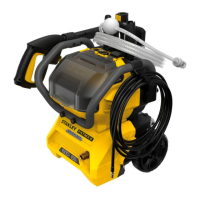
